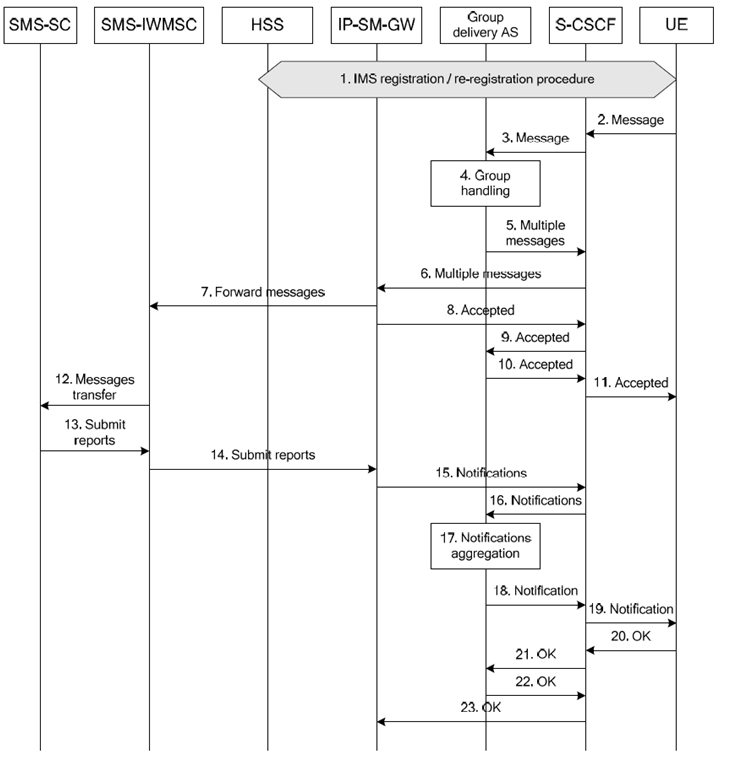Content for TS 23.204 Word version: 19.1.0
A Service-level interworking: IM or CPM user sends an Instant Message to a group list including SMS users |R8| p. 53

Figure A.1: IM user sends an Instant Message to a group list via service-level interworking
(⇒ copy of original 3GPP image)
(⇒ copy of original 3GPP image)
Step 1.
The UE registers to S-CSCF according the IMS registration procedure.
Step 2.
UE generates Instant Message which includes group information, e.g. Group identifier in the Request-URI and/or recipient list in the body of the Instant Message. UE submits the Instant Message to the S-CSCF using an appropriate SIP method.
Step 3.
Based on the stored iFC, S-CSCF forwards the Instant Message to an AS in charge of the group delivery, e.g., the controlling function server defined in OMA-TS-SIMPLE_IM-V1_0 [12] or the controlling function server defined in OMA-TS-CPM_Conv_Fnct-V1_0 [17].
Step 4.
The group delivery AS replicates per Instant Message for per recipient according to the group information it obtains acting as a B2BUA. See detail in OMA-TS-SIMPLE_IM-V1_0 [12] or in OMA-TS-CPM_Conv_Fnct-V1_0 [17].
Step 5.
The group delivery AS sends the generated multiple Instant Messages to S-CSCF (e.g., the Instant Messages can be delivered as what the list server does defined in the TS 24.247).
Step 6.
The S-CSCF forwards the Instant Messages to the IP-SM-GW based on the stored iFC.
Step 7.
The IP-SM-GW shall decide whether to perform service-level interworking depending on SIP request header (e.g. Request-URI), operator policy, when the Instant Message is not routeable in the IMS. If IP-SM-GW decided to perform service-level interworking, the IP-SM-GW performs service authorization based on the stored subscriber data retrieved from the HLR/HSS at the time of the third party registration procedure as described in the clause 6.1. The IP-SM-GW shall check whether the originating subscriber is authorised to use the interworking service. If the result of service authorization is negative, the IP-SM-GW shall not forward the message, and shall return the appropriate error information to the UE in a failure report. Otherwise, the IP-SM-GW shall translate the IMS message to a Short Message (SMS- SUBMIT) and forwards it towards the SMS-SC (SC Address) via the SMS-IWMSC (as described in TS 23.040).
Step 8.
If service authorization is successful, the IP-SM-GW acknowledges the Instant Messages.
Step 9-11.
Instant Message acknowledgement is forwarded by S-CSCF to UE.
Step 12.
The SMS-IWMSC forwards the Short Messages (SMS- SUBMIT) to the SMS-SC (see TS 23.040).
Step 13.
The SMS-SC sends multiple Submit reports (SMS-SUBMIT REPORT) to SMS-IWMSC (see TS 23.040).
Step 14.
SMS-IWMSC sends the Submit reports to IP-SM-GW (see TS 23.040).
Step 15.
IP-SM-GW translates the received Submit reports to appropriate IMS delivery notifications defined in RFC 5438, and forwards the IMS delivery notifications to the S-CSCF.
Step 16.
The S-CSCF forwards the IMS delivery notifications to the group delivery AS.
Step 17.
The group delivery AS aggregates the delivery notifications of the same type from different recipients into a single delivery notification.
Step 18.
The group delivery AS sends the delivery notification to the S-CSCF.
Step 19.
The S-CSCF forwards the delivery notification to the UE.
Step 20-23.
Acknowledgement of the delivery notification is forwarded by S-CSCF to IP-SM-GW.